instrument panel Lancia Delta 2011 Owner handbook (in English)
[x] Cancel search | Manufacturer: LANCIA, Model Year: 2011, Model line: Delta, Model: Lancia Delta 2011Pages: 290, PDF Size: 8.36 MB
Page 110 of 290
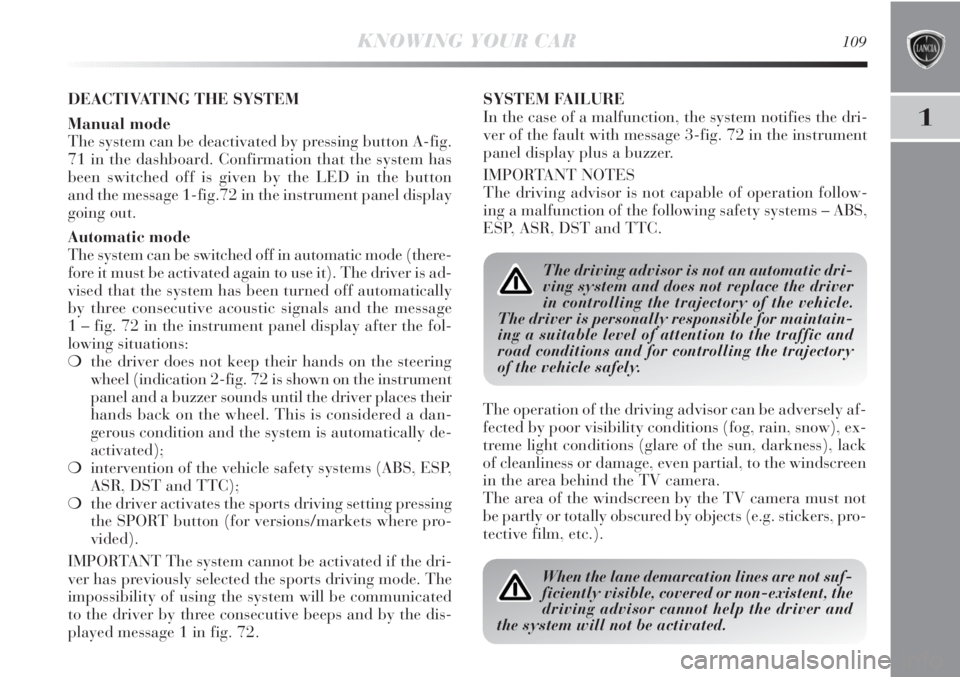
1
KNOWING YOUR CAR109
DEACTIVATING THE SYSTEM
Manual mode
The system can be deactivated by pressing button A-fig.
71 in the dashboard. Confirmation that the system has
been switched off is given by the LED in the button
and the message 1-fig.72 in the instrument panel display
going out.
Automatic mode
The system can be switched off in automatic mode (there-
fore it must be activated again to use it). The driver is ad-
vised that the system has been turned off automatically
by three consecutive acoustic signals and the message
1 – fig. 72 in the instrument panel display after the fol-
lowing situations:
❍the driver does not keep their hands on the steering
wheel (indication 2-fig. 72 is shown on the instrument
panel and a buzzer sounds until the driver places their
hands back on the wheel. This is considered a dan-
gerous condition and the system is automatically de-
activated);
❍intervention of the vehicle safety systems (ABS, ESP,
ASR, DST and TTC);
❍the driver activates the sports driving setting pressing
the SPORT button (for versions/markets where pro-
vided).
IMPORTANT The system cannot be activated if the dri-
ver has previously selected the sports driving mode. The
impossibility of using the system will be communicated
to the driver by three consecutive beeps and by the dis-
played message 1 in fig. 72.SYSTEM FAILURE
In the case of a malfunction, the system notifies the dri-
ver of the fault with message 3-fig. 72 in the instrument
panel display plus a buzzer.
IMPORTANT NOTES
The driving advisor is not capable of operation follow-
ing a malfunction of the following safety systems – ABS,
ESP, ASR, DST and TTC.
When the lane demarcation lines are not suf-
ficiently visible, covered or non-existent, the
driving advisor cannot help the driver and
the system will not be activated.
The driving advisor is not an automatic dri-
ving system and does not replace the driver
in controlling the trajectory of the vehicle.
The driver is personally responsible for maintain-
ing a suitable level of attention to the traffic and
road conditions and for controlling the trajectory
of the vehicle safely.
The operation of the driving advisor can be adversely af-
fected by poor visibility conditions (fog, rain, snow), ex-
treme light conditions (glare of the sun, darkness), lack
of cleanliness or damage, even partial, to the windscreen
in the area behind the TV camera.
The area of the windscreen by the TV camera must not
be partly or totally obscured by objects (e.g. stickers, pro-
tective film, etc.).
Page 113 of 290

112KNOWING YOUR CAR
ADVANCED ESP SYSTEM
(ELECTRONIC STABILITY PROGRAM)
This is an electronic car stability control system in the
event of tyre grip loss, helping to maintain directional
control.
The Advanced ESP system is therefore particularly use-
ful when road surface grip conditions change.
With the Advanced ESP system as well as the ASR (trac-
tion control with intervention on the brakes and the en-
gine) plus the HILL HOLDER (device for hill starts with-
out using the brakes) and also MSR (adjustment of engine
braking force with gear downshift), HBA (automatic in-
crease in braking pressure during emergency braking),
ABS (preventing the wheels from locking and slipping on
all road surfaces during sharp braking and DST (appli-
cation of force on the steering wheel for steering correc-
tion) functions are all available. SYSTEM INTERVENTION
It is signalled by the blinking of the warning light á
on the instrument panel, to inform the driver that the car
is in critical stability and grip conditions.
Switching the system on
The Advanced ESP system comes on automatically when
the vehicle is started and cannot be turned off.
Failure indications
In the event of a failure, the Advanced ESP system will
be automatically switched off and warning light áwill
appear constantly in the instrument panel along with
a message on the reconfigurable multifunction display.
The LED on the ASR OFF button will also light up (see
“Instrument panel warning lights” chapter). In this case,
go to a Lancia Dealership.
The performance of the Advanced ESP sys-
tem should not encourage the driver to take
unnecessary risks. Your driving style must
always be suited to the road conditions, visibility
and traffic. The driver is ultimately responsible for
road safety.
Page 114 of 290
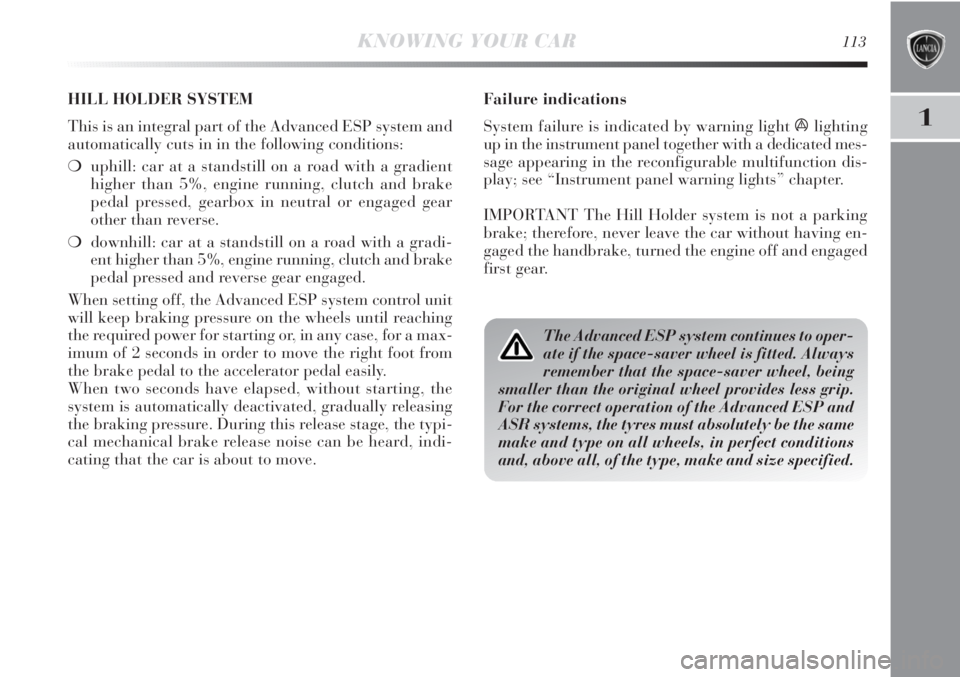
1
KNOWING YOUR CAR113
Failure indications
System failure is indicated by warning light
álighting
up in the instrument panel together with a dedicated mes-
sage appearing in the reconfigurable multifunction dis-
play; see “Instrument panel warning lights” chapter.
IMPORTANT The Hill Holder system is not a parking
brake; therefore, never leave the car without having en-
gaged the handbrake, turned the engine off and engaged
first gear.
The Advanced ESP system continues to oper-
ate if the space-saver wheel is fitted. Always
remember that the space-saver wheel, being
smaller than the original wheel provides less grip.
For the correct operation of the Advanced ESP and
ASR systems, the tyres must absolutely be the same
make and type on all wheels, in perfect conditions
and, above all, of the type, make and size specified.
HILL HOLDER SYSTEM
This is an integral part of the Advanced ESP system and
automatically cuts in in the following conditions:
❍uphill: car at a standstill on a road with a gradient
higher than 5%, engine running, clutch and brake
pedal pressed, gearbox in neutral or engaged gear
other than reverse.
❍downhill: car at a standstill on a road with a gradi-
ent higher than 5%, engine running, clutch and brake
pedal pressed and reverse gear engaged.
When setting off, the Advanced ESP system control unit
will keep braking pressure on the wheels until reaching
the required power for starting or, in any case, for a max-
imum of 2 seconds in order to move the right foot from
the brake pedal to the accelerator pedal easily.
When two seconds have elapsed, without starting, the
system is automatically deactivated, gradually releasing
the braking pressure. During this release stage, the typi-
cal mechanical brake release noise can be heard, indi-
cating that the car is about to move.
Page 117 of 290
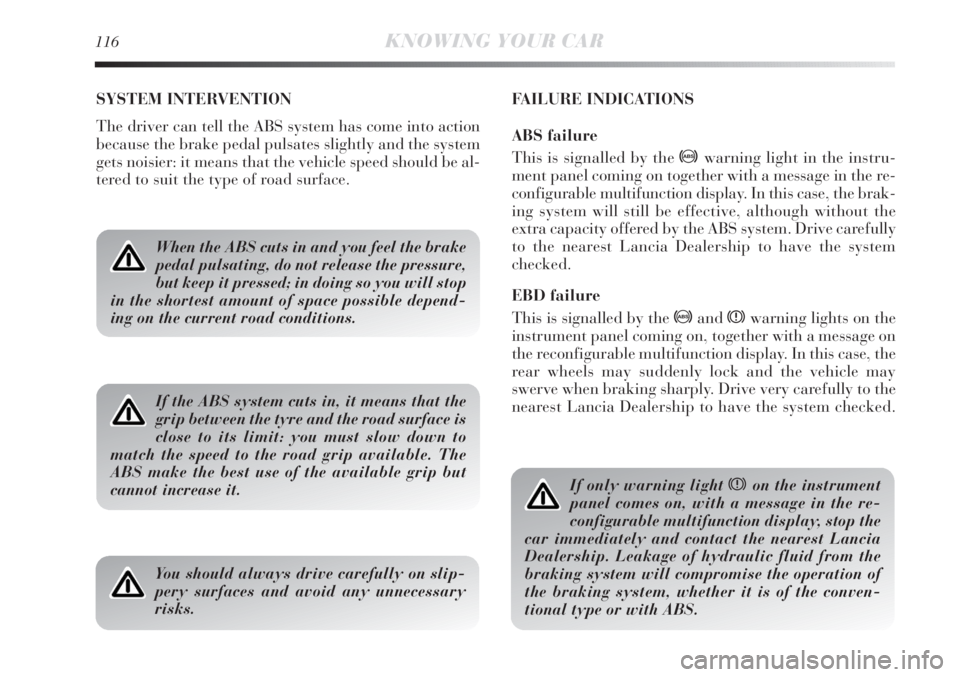
116KNOWING YOUR CAR
SYSTEM INTERVENTION
The driver can tell the ABS system has come into action
because the brake pedal pulsates slightly and the system
gets noisier: it means that the vehicle speed should be al-
tered to suit the type of road surface.FAILURE INDICATIONS
ABS failure
This is signalled by the >warning light in the instru-
ment panel coming on together with a message in the re-
configurable multifunction display. In this case, the brak-
ing system will still be effective, although without the
extra capacity offered by the ABS system. Drive carefully
to the nearest Lancia Dealership to have the system
checked.
EBD failure
This is signalled by the >andxwarning lights on the
instrument panel coming on, together with a message on
the reconfigurable multifunction display. In this case, the
rear wheels may suddenly lock and the vehicle may
swerve when braking sharply. Drive very carefully to the
nearest Lancia Dealership to have the system checked.
When the ABS cuts in and you feel the brake
pedal pulsating, do not release the pressure,
but keep it pressed; in doing so you will stop
in the shortest amount of space possible depend-
ing on the current road conditions.
If the ABS system cuts in, it means that the
grip between the tyre and the road surface is
close to its limit: you must slow down to
match the speed to the road grip available. The
ABS make the best use of the available grip but
cannot increase it.
You should always drive carefully on slip-
pery surfaces and avoid any unnecessary
risks.
If only warning light xon the instrument
panel comes on, with a message in the re-
configurable multifunction display, stop the
car immediately and contact the nearest Lancia
Dealership. Leakage of hydraulic fluid from the
braking system will compromise the operation of
the braking system, whether it is of the conven-
tional type or with ABS.
Page 119 of 290
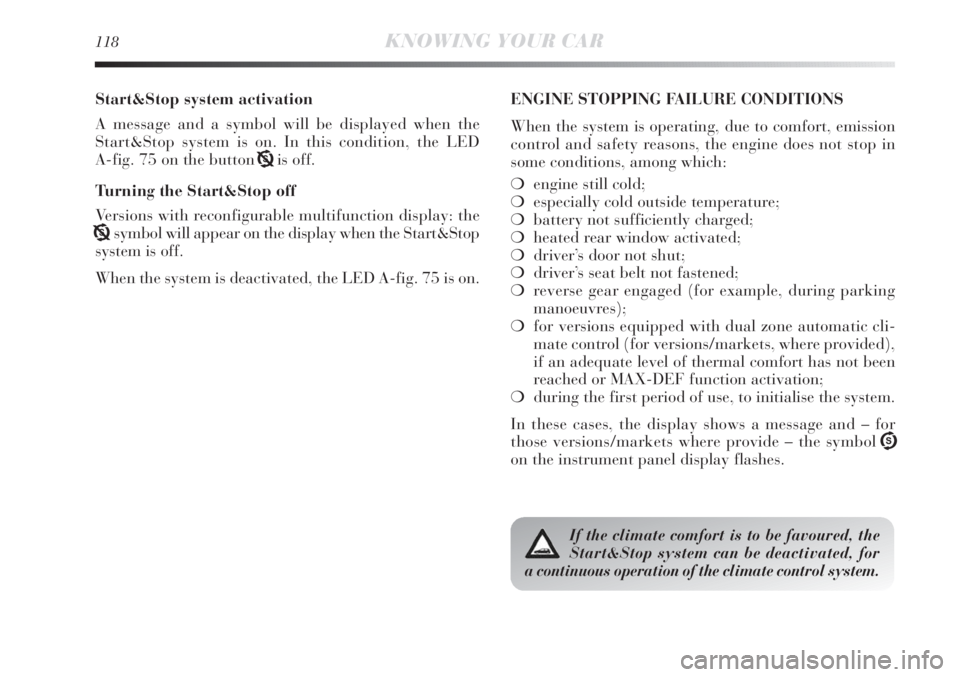
118KNOWING YOUR CAR
Start&Stop system activation
A message and a symbol will be displayed when the
Start&Stop system is on. In this condition, the LED
A-fig. 75 on the button Tis off.
Turning the Start&Stop off
Versions with reconfigurable multifunction display: the
Tsymbol will appear on the display when the Start&Stop
system is off.
When the system is deactivated, the LED A-fig. 75 is on.ENGINE STOPPING FAILURE CONDITIONS
When the system is operating, due to comfort, emission
control and safety reasons, the engine does not stop in
some conditions, among which:
❍engine still cold;
❍especially cold outside temperature;
❍battery not sufficiently charged;
❍heated rear window activated;
❍driver’s door not shut;
❍driver’s seat belt not fastened;
❍reverse gear engaged (for example, during parking
manoeuvres);
❍for versions equipped with dual zone automatic cli-
mate control (for versions/markets, where provided),
if an adequate level of thermal comfort has not been
reached or MAX-DEF function activation;
❍during the first period of use, to initialise the system.
In these cases, the display shows a message and – for
those versions/markets where provide – the symbol U
on the instrument panel display flashes.
If the climate comfort is to be favoured, the
Start&Stop system can be deactivated, for
a continuous operation of the climate control system.
Page 123 of 290

122KNOWING YOUR CAR
EOBD SYSTEM
The EOBD system (European On Board Diagnosis) car-
ries out a continuous diagnosis of the components of the
car related to emissions. It also alerts the driver, by turn-
ing on the
Uwarning light in the instrument panel to-
gether with a message in the reconfigurable multifunc-
tion display, when these components are no longer in
peak condition (see “Instrument panel warning lights”
chapter).
The goal of the system is to:
❍to keep system efficiency under control;
❍to signal a fault which causes emission levels to in-
crease;
❍to signal the need to replace deteriorated components.
The system also has a diagnosis connector that can be in-
terfaced to suitable instruments, to read the error codes
stored in the control unit together with a series of specific
parameters for engine operation and diagnosis.
This check can also be carried out by traffic control au-
thorities.
IMPORTANT After eliminating the problem, to check the
system completely, Lancia Dealerships run a bench test
and, if necessary, road tests which may also call for a long
journey.
Go to a Lancia Dealership as soon as pos-
sible if warning light
Ueither does not light
up when the key is turned to MAR–ON or if,
while travelling, the warning light comes on either
steadily or flashing (along with a message in the
reconfigurable multifunction display). The oper-
ation of the warning light
Umay be checked by the
traffic control authorities using specific devices.
Always comply with the traffic regulations in force
in the country where you are driving.
“DUALDRIVE” ELECTRIC POWER
STEERING SYSTEM
THIS is an electrically controlled power steering system
called “Dualdrive”. It is only operational with the igni-
tion key turned to MAR–ON and the engine running; it
can be customised by the driver according to the driving
conditions.
IMPORTANT When turning the ignition key quickly,
complete power steering functionality may be achieved
after 1-2 seconds.
Page 124 of 290

1
KNOWING YOUR CAR123
CITY FUNCTION ACTIVATION/DEACTIVATION
Press button A-fig.79 to activate/deactivate the function.
When the function is active, the CITY warning light on
the instrument panel turns on.
When the CITY function is on, the effort required at
steering wheel is lighter, making parking easier: there-
fore, this function is particularly useful for driving in city
centres.
FAILURE INDICATIONS
Any failure of the electric power steering is indicated by
instrument panel warning light gcoming on together
with a message in the reconfigurable multifunction dis-
play. In the event of electric power steering system fail-
ure, the car can be driven with mechanical steering.
IMPORTANT In some circumstances, factors independent
of the electric power steering could cause the warning light
gon the instrument panel to come on. In this case, stop
the car immediately, switch off the engine for about
20 seconds and then restart the engine. If the gwarn-
ing light remains on, together with the message on the re-
configurable multifunction display, contact a Lancia
Dealership as soon as possible.
fig. 79L0E0057m
Under no circumstances should aftermarket
operations be carried out involving steering
system or steering column modifications
(e.g. installation of anti-theft device). This could
negatively affect performance and safety, invali-
date the warranty, cause serious safety problems
and also result in non-compliance of the car with
type-approval requirements.
On some versions, with the CITY function
activated, the SPORT function is not avail-
able. To activate the SPORT function, deactivate
the CITY function and vice versa, because they are
reciprocally incompatible.
Page 129 of 290

128KNOWING YOUR CAR
FAILURE INDICATIONS
Any faults in the parking sensor system are indicated,
when reverse gear is engaged, by the
èwarning light on
the instrument panel lighting up and a dedicated message
appearing in the multifunction display.
OPERATION WITH TRAILER
Sensor operation is automatically deactivated when the
trailer’s electric cable plug is fitted in the car’s tow hook
socket.
The sensors are automatically reactivated when the
trailer’s cable plug is removed.
For correct operation, sensors must always
be clean from mud, dirt, snow or ice. Be
careful not to scratch or damage the sensors
while cleaning them. Avoid using dry, rough or
hard cloths. The sensors should be washed using
clean water with the addition of car shampoo if
necessary. When using special washing equipment
such as high pressure jets or steam cleaning, clean
the sensors very quickly keeping the jet more than
10 cm away.
GENERAL WARNINGS
❍When parking, watch out for obstacles that may
be above or under the sensors.
❍Sometimes, objects placed close to the car are not de-
tected and could therefore cause damage to the car
or be damaged themselves.
The following conditions may influence the performance
of the parking sensor system:
❍Reduced sensor sensitivity and a reduction in the
parking assistance system performance could be due
to the presence on the surface of the sensor of:
ice, snow, mud, thick paint.
❍The sensor may detect a non-existent obstacle (echo
interference) due to mechanical interferences, for ex-
ample when washing the vehicle, rain (strong wind),
hail.
Page 132 of 290

1
KNOWING YOUR CAR131
SENSORS
While searching for a parking place, the system uses side
sensors (see fig. 81).
These sensors are automatically activated below around
30 km/h; during this stage if the driver has just passed
a space that might be useful for a manoeuvre, the func-
tion can be requested using the special button; at this
point the instructions for carrying out the manoeuvre will
be shown on the display. If the function is not requested
by the driver using the special button, no information will
be displayed on the instrument panel.OPERATION
The assisted parking manoeuvre can only be activated
with the instrument panel on and at speeds below about
30 km/h and is divided into the following stages:
❍Activation: pressing the button fig. 82 activates the
search stage.
❍Search: through side sensors, the system continuously
searches for a free parking space, suitable to the vehicle
dimensions. The driver determines on which side of the
road they intend to park using the direction indicators (if
no information is available from the direction indicators
or hazard warning lights, the search takes place on the
passenger side).
IMPORTANT The SEARCH stage in the system logic is
deactivated after about 10 mins if a suitable parking
space is not identified.
fig. 81L0E0240mfig. 82L0E0241m
Page 133 of 290
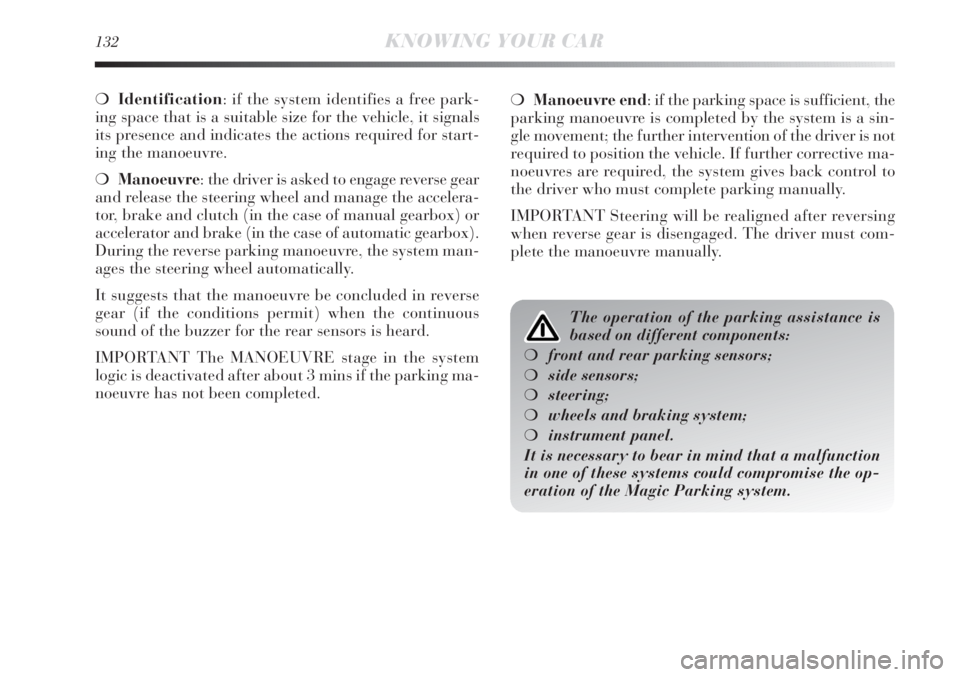
132KNOWING YOUR CAR
❍Identification: if the system identifies a free park-
ing space that is a suitable size for the vehicle, it signals
its presence and indicates the actions required for start-
ing the manoeuvre.
❍Manoeuvre: the driver is asked to engage reverse gear
and release the steering wheel and manage the accelera-
tor, brake and clutch (in the case of manual gearbox) or
accelerator and brake (in the case of automatic gearbox).
During the reverse parking manoeuvre, the system man-
ages the steering wheel automatically.
It suggests that the manoeuvre be concluded in reverse
gear (if the conditions permit) when the continuous
sound of the buzzer for the rear sensors is heard.
IMPORTANT The MANOEUVRE stage in the system
logic is deactivated after about 3 mins if the parking ma-
noeuvre has not been completed.❍Manoeuvre end: if the parking space is sufficient, the
parking manoeuvre is completed by the system is a sin-
gle movement; the further intervention of the driver is not
required to position the vehicle. If further corrective ma-
noeuvres are required, the system gives back control to
the driver who must complete parking manually.
IMPORTANT Steering will be realigned after reversing
when reverse gear is disengaged. The driver must com-
plete the manoeuvre manually.
The operation of the parking assistance is
based on different components:
❍front and rear parking sensors;
❍side sensors;
❍steering;
❍wheels and braking system;
❍instrument panel.
It is necessary to bear in mind that a malfunction
in one of these systems could compromise the op-
eration of the Magic Parking system.